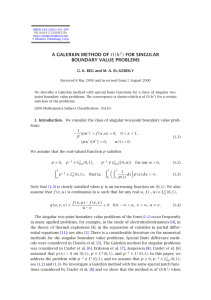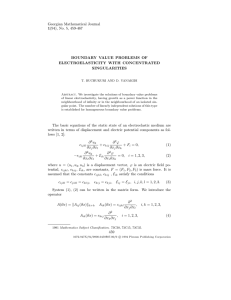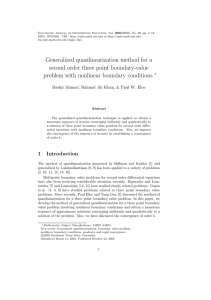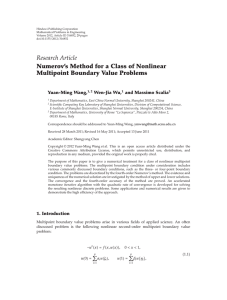RANDOM BOUNDARY VALUE CONTAINING WEAKLY CORRELATED
advertisement
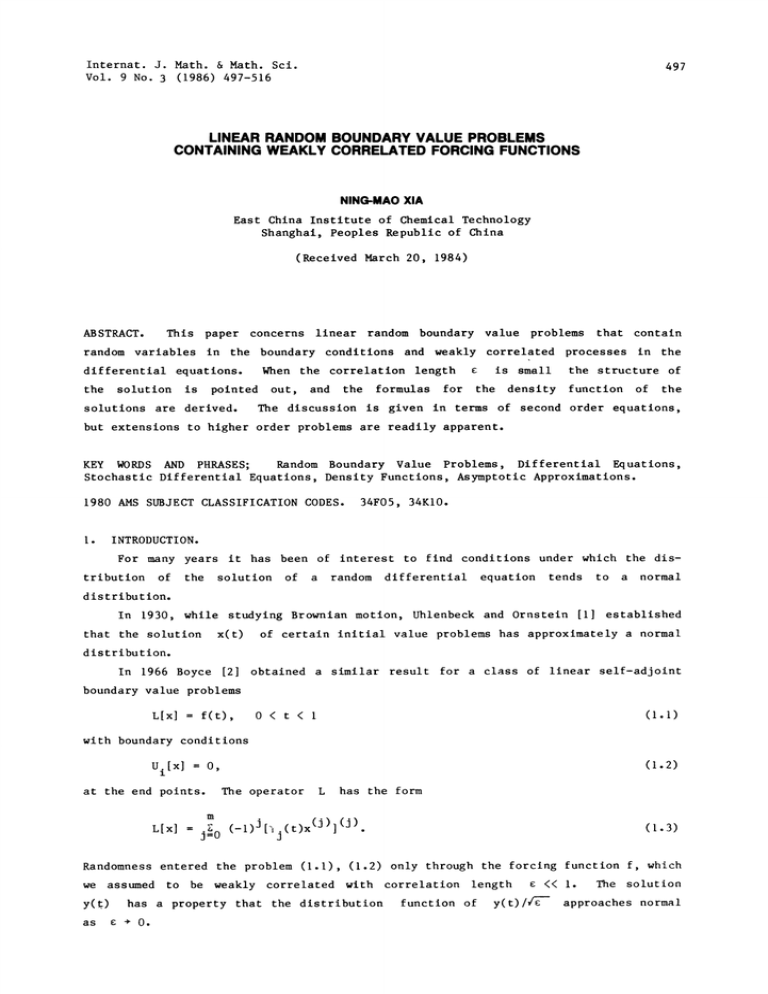
Internat. J. Math. & Math. Sci.
Vol. 9 No. 3 (1986) 497-516
497
LINEAR RANDOM BOUNDARY VALUE PROBLEMS
CONTAINING WEAKLY CORRELATED FORCING FUNCTIONS
NING-MAO XIA
East China Institute of Chemical Technology
Shanghai, Peoples Republic of China
(Received March 20, 1984)
Thls paper concerns linear random boundary value problems
ABSTRACT.
that contain
random variables In the boundary conditions and weakly correlated processes in the
When the correlation length
differential equations.
the
solution
solutions are derived.
and
out,
pointed
is
the
formulas
for
e
is smmll
the
density
the structure of
function
of
the
The discussion is given in terms of second order equations,
but extensions to higher order problems are readily apparent.
Random Boundary Value Problems, Differential Equations,
WORDS AND PHRASES;
Stochastic Differential Equations, Density Functions, Asymptotic Approximations.
KEY
1980 AMS SUBJECT CLASSIFICATION CODES.
I.
34F05, 34KI0.
INTRODUCTION.
For many years it has been of interest to find conditions under which the disof
tribution
the
solution
of
random
a
differential
equation
tends
to
a
normal
distribution.
In 1930, while studying Brownlan motion, Uhlenbeck and Ornstein [I] established
x(t)
that the solution
of certain initial value problems has approximately a normal
distribution.
In 1966 Boyce [2] obtained a similar result for a class of linear self-adjoint
boundary value problems
L[x]
f(t),
0
<
t
<
(I.I)
with boundary conditions
U.[x]
at the end points.
The operator
m
e[x]
(1.2)
O,
j0
L
has the form
(-l)J["j (t)x(j)](j)"
(1.3)
Randomness entered the problem (I.I), (1.2) only through the forcing function f, which
we assumed
y()
as
to
be weakly correlated with correlation
has a property that the distribution
g
O.
length
function of
e
y(t)/e,r
<<
I.
The solution
approaches normal
N.M. XIA
498
When
f,
o,...,m_l,m
are
small
weakly
independent
correlated
processes,
Purkert and vom Scheidt [3,4]; Boyce and Xia [5] found a similar and better results by
combining the methods of [2] with perturbation and Chebyshev-Hermite polynomial
expansion.
Here we extend the results of [2] in another way, our problem need not be selfadjoint and the random parts of the forcing terms need not be small.
(x)
0 we can always rewrite equation (I.I) into a standard linear
m
so instead of (1.1) in this paper we consider a general linear system with
When
system,
random boundary conditions and with weakly correlated processes in the forcing terms.
In Section 2 we will define the problem and derive the functional form of the
Section 3 contains some preliminary results that are required later.
solution.
main results of
this paper are in Section 4,
e
that is when
0
The
we can find the
asymptotic approximation for the density function of the solution which has a nice
structure, namely it consists of three functions, one is deterministic; one can be
obtained
in
terms
of
the
random boundary conditions;
and
the other,
contribution of the random forcing terms, has the normal distribution.
of
2.
which
is
the
The usefulness
expression is illustrated by the examples in Section 5.
his
STATEMENT OF THE PROBLEM AND THE FORM OF THE SOLUTION.
Although
we
section
the
same methods
consider
the
can be
applied
higher
to
random boundary value
linear
order
problem of
problems,
in
this
the second order
differential equation.
d(t)
(t)(t) + (t)(t,) + (t)
dt
Dx(0) + x(1)
A(t), B(t), DI D2
where
a21(t)
DI
(2.1 b)
are deterministic
are
C(t)
B(t)
a22(t)
2 x 2 matrices
(bll(t)
b21(t)
b22(t)
)
(2.2)
d 22
2 x
vectors
(Cl(t),C2(t))
!(t,m), (m)
T
are random
x(t)
2 x
(x(t),y(t))T,
vectors defined on an underlying probability
(,F,P)
space
(t,)
We
(l(t,m),2(t,m))
T
()
are interested in the case in which
(e(m)
(m))T
l(t,m)
weakly correlated with the same correlation length
has
bl2(t)
(2.3)
(I)
d
k 21
C(t), x(t)
and
(),
(all(t) al2(t))
A(t)
(2.1 a)
been
defined
(t l,t2,...,t n)
l(t,)
and
e.
and
2(t,m)
The term "weakly correlated"
by Purkert and vom Scheidt [3,6,4] in the following way.
be an n-tuple of real numbers and let
e
are
>
0
be a positive
Let
S
constant.
LINEAR RANDOM BOUNDARY VALUE PROBLEMS
Let S
(til ti2
this
necessary.
Then
always
S
til _< ti2 _<
be a subset of S, and suppose that
,tik)
can
ordering
499
be
by
attained
relabeling
g-neighboring
is said to be
elements
the
<_ tik;
of
S
if
if
(2.4)
A single
element
subset is always e-neighboring.
S,
g-neighboring, with respect to
if
any larger e-neighboring subset of
S.
S
The subset
It can be shown [6] that
S
disjoint maximally e-neighboring subsets in a unique way.
into
h(t,m)
process
S
is maximally
is e-neighboring but is not contained in
can be separated
Then a stochastic
is said to be weakly correlated with correlation length
e
if, for
each n,
<h(t l,m)...h(tn,m)>
<.>
where
<h(t11,m)---h(tlp l,m)>’--<h(tkl,m)-’’h(tkpk,m)>
denotes the mathematical expectation and the n-tuple
(tll’ "’’tlPl
into the maximally e-neighboring subsets
k
iZ=1
Pi
(t
S
k 1’
(2.5)
has been separated
t
with
kPk
n.
In this paper we assume that
l(t,m)
2(t,m)
and
have the property (2.5), and
without loss of generality we also assume that
<l(t,m)>
<2(t,)>
0,
Otherwise we can redefine
For the case
n
C(t)
(2.6)
0
so as to include
(t,m)>.
the condition (2.5) reduces to
2
<i(tl,m) i(t2,)>
i
Itl t21
R.(tl,t2),
(2.7)
i. 2.
<
1
Now we consider the form of the solution of problem (2.1).
matrix of
fundamental
the homogeneous
system corresponding
to
Let
(2.1).
(t)
Then
be the
(t)
satisfies
d(t)
A(t)(t),
dt
where
is the
and nonsingular
2 x 2
2 x 2
(0)
(2.8)
I
identity matrix,
(t)
(ij(t))
is a uniquely determined
matrix.
With the assumption that
-i
(i + 2(I))
exists we can easily find the funda-
mental matrix of the homogeneous system corresponding to (2.1 a) and the boundary condition (2.1
b).
(t),
Let this fundamental matrix be
then
(t)
satisfies
d(t)
dt
A(t)(t),
DI!(0) + D2!(1)
I
(2.9)
and is given by
!(t)
!(t)[D1
+ D2!(1)]
-I.
In order to find the solution of (2.1), we set
(2. lO)
500
N.M. XIA
(t)
where
(t)
If we
(t)(t)
(2.11)
T
(kl(t),K2(t))
substitute (2.11)
2 x
is a
into
vector to be determined.
(2.1 a) and use (2.9), we have
d(t)
(t)(t,) + (t).
(t) at
-I
[I + 2(I)]
In the case
d(t)
-I
exists we find that
(t)[(t)(t,) + (t)]
dt
-I
[I + 2(1)](t) [(t)(t,) + (t)],
and then
K
K(t)
(t))
K2(t
t
-I()[B()(,) + C()]d
() + DI(0)
0
(2.12)
$-l(T)[()(,m)
2(I)
+ ()] d
t
t
(t)
(t)[() + I(0)
-I()[()(,)
+ ()] d
0
(2.13)
D2(1)
f -l()[B()(,0)
+ C()] d]
t
where the boundary condition (2.1 b) has been used to obtain the last two results.
3.
SOME PRELIMINARY RESULTS.
In order to obtain the density function of the solution
(t),
we first rewrite
it into the following form
t
f -1()()dz
(t)[() + I(0)
(t)
D2(1)
0
t
+ I(0)
/ $-l()g(rl(,)d
2(11
0
ft -l()()dz
f g-l()()
d]
t
(t)() + 6(t) + ](t,),
(3.1 a)
wher e
(t)
(l(t),62(t))
(3.1 b)
t
(t)Dl(0)
is a deterministic
l(t,)
2 x
f -l()C()d
(t)D2(1)
0
vector, and
(Yl(t,),Y2(t,o))
f -I()C()
d
t
T
(3.1 c)
t
(z)B(z)(z ,)dt
0
(t)D2(1)j
t
is a random
2 x
vector.
-1 (Z)(Z)(z
LINEAR RANDOM BOUNDARY VALUE PROBLEMS
501
If we set
nl(T)
rl(T)
n3(T)
r3(1)
1
(t) Dl(0)- ()B()
(3.2)
In2(T)n(1) rr2())()
(t)D2(1)-I(1)B(T)
then
(3.3)
n3(t,) +
Y2(t,m)
where
t
nl(t,
] [nl(1)l(I,)
0
2(t,)
f
+ rl(1)2(T,))dl,
[n2()l(, ) + r2()2(,)]d,
t
(3.4)
t
[n3(T)I(T, ) + r3()2(,m)Id,
n3(t,
0
f
(t,0)
[n()l(T,m) + r()2(,0)]d.
t
l(t,)
From now on we always assume that
processes
correlated
e
0, l(t,)
with
n2(t,); 3(t,)
and
and
2(t,) are independent weakly
e, then we can show that as
the same correlation length
and
(t,)
will be independent and they will
have the normal distributions.
In order to prove this and then to obtain the density function of x(t) and y(t),
the following properties are required.
[Property i]
If we have
t
Al(t)
[n21()Rl(,T + r21(1)Rm(I,I)]d
2
0
0
(3.5)
Bl(t)
2
[n22(T)RI(,) + r22()R2(,)]d
/
t
then for
n
<
R__J__I
/A---
]
2n
2n +
(2n)’ + 0(e)
2nn!
>
n2
rl 2
2n
2n +
(2n)!
2nn!
>
O(e m)
n
A3
I!
l(n-
AI
I)!
3/2
I/2 + 0( 3/2
B3
(2n + I)!
n
(3.6 b)
3.6 c)
+ 0()
3!2
A3(t), B3(t
(3.6 a)
(2n +
3!2
and
0
1,2,...
i
where
#
(n
I)!
BI
3/2
are the corresponding main parts of
denotes the term with the order
d
>
m
1/2
3/2
+ 0(
<i>
and
(see [5,2]).
<n32>
(3.6 d)
respectively,
502
N.M. XIA
[Property 2]
If
I,K 2
K
(i
1,2,... and
KI + K2
then
t
K
t
/... /...f
0
[...]dl...dKl
t_St
0
g-neighboring
+ K2
0(e
+K2
is
).
(3.7)
K2
K1
[...]
where the integrand
any fixed number between
Proof:
is any function having continuous derivatives, and
t
is
I.
and
0
K
Consider the case
2, K 2
for simplicity.
Then the region of
integration is
{i,2,31
G3
From
0
<__
The
the
Z <__
region G
IIe [0,t], 12
(i,2,3)
of
definition
e, 0
__<
2
i
e
[0,t], 13 e It,l]
is g-neighboring
<__
>
and if i
know
we
g-neighboring
e;
then
2 > I
o
e,
_< i- 2
i <
that
_<
2 then 0
if
3
e.
can be divided into two parts
G I) (J G 2)
G
_<
(3.8)
where
G I)
{II,12,131
G 2)
{Ii,12,131
Ii e [0,t], 12 e [0,t], 13 e It,l]
(3.9 a)
and
Ii e [0,t], 12 e [0,t], I e [t,1]
0
<__
3
i
__<
e,
<__
0
NOW we consider the distance between the point
point
(t,t,t).
T
__<
2
i
Because of (3.8) we may assume
}.
(3.9 b)
e
P
(i ,2,3)
P e
G
1)
in
G
and the
and then from (3.9 a)
we find that
t
<_
13
<_
12 + e,
t
<
<
t
e
t
_<
e
13
<_
_<
12
2e
t
t,
_<
12
e
_< II _<
or
+ e,
t
e
_<
12
/ (Ii
t
2e
t
_<
I
_<
t.
p(P,T) is
An estimate for the distance
O(P,T)
_<
t) 2 + (2
t) 2 + (13
t)2 _<
/
(2e)2 + e2 + e2
0(e).
From this estimate we have
G3
.fff
G3
did2d
+ 0(e)
fff
G3
did2d
t,
LINEAR RANDOM BOUNDARY VALUE PROBLEMS
<--I[’’’]]P
T
"’[ d’rld2d’r3
503
+ O(e) j’j’j" dl:ld’r2dl:
03
03
0(e 3)
03
where
is a ball, with center at
(3.7); for other
Thus we have proved
[Property 3]
If
<
KI,K2
t
0
0 t
(K
+ K 2)/2
>
,KI +
(3.1o)
have the same properties as in (3.7).
t
[0,I], B(t) e
e C
of
different
CI[0,1],
For
K I,K 2
use
KI
K
K2
or
0
In
1,2,
I
K2
C(t)
>
0
(3.11)
e
CI[0,I],
l(t,m), 2(t,)
KI,K2 0,1,2,...
for
orders
derivatives, then we have the conclusion that for
Proof:
g-neighboring then
If we assume that the coefficients of equation (2.1 a) have the
A(t)
expectations
i
is
K2
o(e
where we assume that the integrand and
matical
(Zl
(KI + K2)/2
t
[Property 4]
< /--.
2
t
properties that
and with radius max(P,T)
the situation is similar.
and
1,2
KI,K2
....
K
K
(t,t,t)
T
is
<
Now
obvious.
and all the mathehave
continuous
>
0(e).
we
consider
(3.11)
<
order to find the contribution of
>
(2.5) and consider all different maximally g-neighboring subsets
we
(ll,...ipl),...
K
’(KI’
(il’
’TiP.)
boring
subsets
are
g-nelghboring subsets
(iI
(
iPi
riqi+
’KPK
with
y"
IPi KI+
i
of two distinct kinds.
for
which
least
at
’ iqi ’ iqi+1 ’ iPl
ii
I’’’’’ zi Pi e [t,l].
"’’
ip
e
These maximally
g-neigh-
The first kind consists of all maximally
one of its subsets has the property that
)’
’ iqi
ii
e
[0,t], and
The second kind consists of all maximally g-neighboring
subsets for which every subset has the property that
iI
K2"
il"’’’iPi
e [0,t] or
[t,1].
i
Because of (3.6) and (3.10), we know that all integrals on the maximally
boring subsets of the first
kind have the order
e;
integrals on the maximally g-neighboring subsets of the second
tribution of
<
For example, when
><
K
>,
2, K 2
2,
kind are just the con-
then we have the conclusion (3.11).
we consider
g-neigh-
and if we notice that all the
N.M. XIA
504
t t
>
<
AIBIZ
f
<[...]>
dld2d3d
(3.12)
0 0
where
<[...]>
<[nl(l)51(l) + rl(l)52(l)][nl(z2)51(2) + ri(2)52(2)]
[n2(3)51(3) + rz(E3)Z(3)l[n2(E)l(g) +
For simplicity we only pick the first term in the integrand, that is
t t
A1BI 2
f fff
nl(l)nl(2)n2(3)n2(g)<l(l)51(2)l(3)51(g)>dld2d3dtg
0 0 t t
t t
f fff
AIBI E2 00 t t
R123
t t
f f nl(El)nl(2)<51(l)51(2)>d1d2"f f
2
t t
0 0
A1B1
n2(B)n2(Yg)<l(3)l
R3g
R12
t t
AIBIe
f f ft ft
A1B1
f ft nl(l)n(3)<l(:l)l(:3)>d:ld:3f0 ft
z’
nl(l)nl(2)n2(3)n2()<l(l )l(2)><l(3)l(g)>dId2d3dg
0 0
(R12 x R3) [ R123g
t
t
+
nl(2)n2(:g)<l(2)l
0
R2
R
t t
Z
f fff
nl(l)nl(:2)n2(:3)n2 (g)<l(:l)l(3)><l(z2)l(g)>dYld:2dr3d:g
0 0 t t
A1Blg
(R
x
R2)f
R12g
t
t
+
Z
AIBIg
f f
nl(l)n2(T)<l(l)51()>dl d
Jf
nl(2)n2(3)<l(2)1(3)>d2dT
0 t
0 t
Rlg
R23
t t
z
AIBI
f f ft ft
nl(l)nl(2)n2(z3)n2( )<I(I)KI())><I(2)KI (z3)>did2d3dg
0 0
(Rig x R23)
R123g
t t
z
f f ft ft
nl(zl)nl(2)n2(3)n2(zg )[<I(I)I(2)I(3)I(g)>
0 0
AIB2g
R123
<l(-rl)l(,r2)><l(’r3)l(’r4)>- <l(’[1)l(’r3)><l(2)l(Tt)>
<1 (’rl)1 (’rg)><l (’r2)E1 (’r3)>]d’rldr2d’r3dEg
tt
+
2
AIB
e
f f
0 0
R12
nl(Yl)nl(z2)<l(Yl)l (Y2)>dzldY2
f f
t t
R3 g
n2(3)n2(E)<l(3)l(Z)>d3dg
LINEAR RANDOM BOUNDARY VALUE PROBLEMS
t
t
+
2
AIBI E
f f
nl(II)nR(T3)<l(l)l(3)>dId3
0 t
J It
0
nl(2)n2(4)<l(T2)l()>dI2d
R2
RI3
t
t
+------ f f
AIBIE
505
nl(l)n2()<l(l)l()>dId4
ff
nl(2)n2(3)<l(2)l(3)>d2d3
0 t
0 t
R23
Rl
(3.13)
are maximally g-neighboring of
where RI234,RI2,...,R23
I,2,3,; I,2;---;2,3
respectively, and (2.7) has been used to obtain the last result.
By means of (3.10), we can have
t t
(3.13)
/
z
AIBI E
nl(%l)nl(%2)<l(%l)l(%2)>d%Id%2
0 0
RI2
f f
n2(IB)n2(%4)<l(%3)l(I4)>d%3d% W + O(E).
t
t
After using the same procedure for other terms in (3.12), we find
<--_.
4.
>
B
<--_><--_> + o( ).
THE DENSITY FUNCTION AND THE STRUCTURE OF THE SOLUTION.
In this section we will consider the density function of the solution
if we notice that the situation will be simple when
interest is in the case when
In
nl(t,)
pl(vl,v2)
We introduce a new function
P
where
p
have for
nl
n2
(Vl)
x(t),
I,
(t)
and
so our main
we first consider
Yl(t,m)
or
(Vl’V2)
P
nl
(Vl).P
n2
such that
(4.1)
(v2) + Pl(Vl,V2)
and so on.
is the density function of
Because of (3.!I) we
0,I,...
K1,K2
K
f f v
f f
t
which are defined by (3.4).
n2(t,)
and
or
(0,I).
t E
to find the density function of
order
0
t
K2
Pl (Vl
v2
,v2)dvl dv2
KI K2
Vl
v2
P
r2
(vl ,v2)dvl dv2
(4.2)
K
f f
Vl
K2
v2
Pnl
(vl)
Pn 2
(vz)dvldV2
506
N.M. XIA
KI
Klf IK2 >
n2
>4 1
>
o().
Then from (4.1) we know when
e
is a small number but not zero
Vl
pQl,B2(Vl,V2)
e/
v2
() P
p
AIB
Vl
() +
r2
PI(
e/Al B
v2
AIg’ BIe
and from (3.3) we have
PYI (v)
Pnln2 (z,v-z)dz
e/AIB
(.v z )dz
P (z____)
/Ale P2 /B-7
f
Pl
e/AIB
z
v
+
(4.3)
Z)d z
/A-- /le
()
Under the assumtion that the density function of
(t)(m),
easily find the density function of
and
(t)a(0)
Det
(t)
(al(m),ae(m))
-I
pa(a,8),
we
pas(e,B)[Det (t)-l[
pala2(a l,a 2)
where
is
T
(4.4)
the
is
Pal a2
function of
density
(t)
is the determinant of the inverse matrix
al()
Then the density function of
Pal(al) f
can
that is
al(m)
a2(o)
-I
is
Pa la2(al,a2)da2
(4.5)
J Pa(,)l Det (t)-l[
Because of (3.3) and (3.4) if we
for every
[0,I], then
t
PI
+ YI
(w)
al()
and
da 2
(a
assume
(m)
that
Yl(t,m)
f
j
pal(W-
v)p
(TAe)p
I
+
e/AIB
+ Yl
is
f f Pa
the density
(w
v)pl(
function of
z
2
(v
(t,m)
Z)dzd v
/B e
,/i e
/Ale
Pal
independent of
Pal (w v)PyI (v)dv
e/AIB
where
is
will be independent and we have
v
z
(4.6)
_dzdv
/A--- /Big
al +
YI-
The second
integral can be
LINEAR RANDOM BOUNDARY VALUE PROBLEMS
507
written as
pal(W_
’A1B
/AIBI
where
-
z/Ale,
S
T
If we can expand
pal(W-
v-
z
v)Pl(A_
f
Z)dzd v
CBI
pu
(w-
TB--
pul(W TB-z)/B-Ie.
pa
into a Taylor series in
-
C
0
i,j
dSdT
(4.7)
SA--)pI(S,T)dSdT
(v-
SIe)
SA--)PI(S,T)/IB
S, T
ijSiTj
and allow the following analytic procedure, then after using (4.2) we have
F.
(4.7)
0
i,j
SIT3pI(S,T)dSdT
C*ij
0().
Thus (4.6) becomes
(w)
Pal +Y
eAIBI
f f P*I (w-
v)p
i
z_____)p
I--
2
(v
Z)dzd v
+ 0(e)
,/BI e
and from (3.1a) we have
Px(X
where
e’Al BI
61
x,
f
pal(X- 61
-v)p
are the first component of
I
(/_z_ _ A_
)P
(t) (t)
2
(v-______Z)dzd v
/le
+ 0(e)
respectively, and
Px (x)
(4.8)
is the
density function of x.
In order to obtain the asptotic approximation for
[see [5]],
ing facts
#A
exp(-
(v I)
1
we need the follow-
2
I
Vl
P
Px(X),
)[I
Hl (vl) +
+
e
(4.9)
2
2
v2
P
i
where
H
r2
exp(- A---)[1 + # H2 (v 2) + ...]
(v2)
2
H2
are certain polynomials of degree
denote some polynomials with the order
I, 2
respectively and the dots
e.
To substitute (4.9) into (4.8), we obtain
Px(X)
I
+
12 +
13 + 0(e).
(4.10)
508
N.M. XIA
where
11
2AIB--2gAIB 2
13
v)exp[-
_PI (x
61
(x
61
]
2/AIB
61
(x
Pa
Pa
z2
(v- z) 2
(I +
v)exp[-
v)exp[-
BI
)dzdv,
l_z + ,(v -, z) 2 ]HI’l z--)dzdv’
2’I
B1
2-e
x2
z)
BI 2) ]H2
+ (v
(V 7. Z)dzdv.
Ble
From the fact
exp[-
2gAIB 2
W.C.
where
2-e
z2
(v-
+
BI
z))]
6(z,v- z)
6
denotes weak convergence, and
lim I
e
0
Pa
(x
61
12
and
(
O)
is the Delta function; we have
v)6(z,v
z)dzdv
pal(xand if we can show that
e
are bounded as
13
then in (4.10) we can
0,
keep the first term as the main term.
In fact for
lim
Iz
+0
if we set
lira
aoll
I
H
or
0
a
constant, we have
o
61),
aoPal (x
/0
ZI
and for
12
or for
,2,...
13
2
where
we can use the similar way to
0,I
obtain the conclusion.
Thus as
e
0
we can consider
obtain the asymptotic formula for
Px(X)
nl(t,)
and
n2(t,)
to be independent, and we
x(t)
f f Pel (x
2g/A-
6
v)exp[-
2
(z + (v
’I
BI
z) 2 )
]dzdv
(4.11)
/2e(A1 + B l)
61
where
The
x(t),
pa
61
v)exp[- 2e(A
+
B1)]dv,
can be evaluated in terms of (3.1b) and (4.5) respectively.
asymototic formula for
y(t),
which is the second component of the solution
can be obtained in a similar way.
By
solution.
that
and
J" Pal (x
means
of
these
asymptotic
we
formulas
can
find
the
If we recall the functional form (3.1a) of the solution
(t)(m)
is the solution of the equation
dx( t
dt
A(t)x(t),
Dlx(1) + D2x(1)
(m)"
structure
x(t),
of
the
and notice
LINEAR RANDOM BOUNDARY VALUE PROBLEMS
(t)
509
is the solution of the deterministic equation
dx( t
A(t)x(t) + C(t),
dt
and that
(t,m)
.p.D x(O) + .X.X(
(Yl(t,m),Y2(t,m))
T
.qO;
(nl(t,m),n3(t,m))T+
(n2(t,m),n(t,m))
is the solution of the equation
dx( t
where
x(t)
0
p.Dx(O) + x(
A(t)x(t) + B(t)(t,m),
dt
is a 2 x
0,
vector with zero components, then we can say that the solution
has such kind of structure that it consists of three functions, the first one is
(m);
(t,m).
the contribution of
contribution of
the second one is deterministic, and the last one is the
When
e
0
every component of the last function has the
e(A + BI)
normal distribution with the mean value zero and the variance
and it can
be divided into two independent normal random processes.
5.
THE JOINT DENSITY FUNCTION AND THE EXAMPLE.
D I, D2
If the matrices
(2.1b) have the forms
in the boundary condition
(5.1)
0
0
d21
d2
then we can find the joint density function of the solution
x(t)
(x(t),y(t))
T.
fact under the assumption (5.1), the solution is
x(t)
where
(t)[(m) +
(t) +
(t,m)]
(5.2)
t
6
,
(t)
,
f
(t)l
ft
62(t)
* (t o)
m l(T)d
0
I
(t,),
Y (t,w)
2
m2(T)d
i n*
() (,,oa) +
(n * () (%,m)+
2
r*
() ( ,))d
2
/
(5.4)
r*2 () 2 (%,m)) d /
and
I()C(%)=
*
n (:)
-I(’r)B’B"(’r)
(5.5)
_m2(%
l-ln:(’r)
* ()’\
-r*2(%) ]
(5.6)
N.M. XIA
510
] (,m),
If we know the density function of
] pe(w -,
p+,(wl,w2)
pas,
where
p,
w2
B)p],(e,B)dsdB,
(m)
are the density functions of
(m)
the independence assumption of
and
then
(t,)
(5.7)
*(t,m)
and
has been used again.
But compare (5.4) with (3.4), we can find the fact that
forms
except
*
respectively.
similar
*
*
*
n I, r I, n2, r2
that
the
r
functions
n
a, w2
B)P
respectively, and
r2
n2
i, n2; Y*,
Y*
have
repalced
been
have the
Z
by
It follows that
p+],(Wl,W2)
A*B*
/ / Pes(Wl
8
)p
* /A*
YI
/A*
B*
e
’)dad8 + 0(e),
/B*
*
Y2
e
pa+,+l,(w ,we)
+ 0(e).
In a similar way we have the asymptotic formula
exp[-
-
f i p=(w
(wl ,w2
Pa+*+y
2-’
and
2n e/A’B*
)
(5.8)
is the density function of
( * (t), 6 * (t) )T
* (t)
6 *2
2
(5.9)
wl
w2
Px
w2
e2 + 82
"’)
Px(X,Y) Pa+6,+,(wl,w2)[Det -l(t)[[
where
,
6"
A
* B
x(t)
v_i(t)(x)
y
x( t) y( t)
can be evaluated by
T;
and
(5.3), (5.5), (5.6) and the
2
formula
,
n
*
n2,
(3.5)
which likes
,
r
1,
r
*
but the functions
nl, n2, rl, r2
need to be replaced by
respectively.
2
Now we consider the first example
()y
0
-2
x(0)
(),
x
-3)(y
y(1)
+
(-i
B(m),
0
I (t,)
2(t,m
+
(0)
(5.0)
LINEAR RANDOM BOUNDARY VALUE PROBLEMS
where
length
l(t,), 2(t,) are independent weakly
<l(t,)> 0, <2(t,)> 0,
correlated processes with correlation
,
RI(T,T)
R2(,)
I,
I,
p8(,8)
and
511
exp (-
2 + 82 ).
2
(5.11)
It is easy to find that
(ll(t) 12(t))
(t)
21(t)
-I
(t)
e
2e
+ 2e
-t
e
-2e-t+
22(t)
2t
-t
-2t
2e
e
-2t
-e
-t
e
-2t
-t+ 2 e-2t
)
(5.12)
-I + e
A
B
A
(222(I)
-t
21(I)) + 2e (21(I)
B
(222(I)
21(I)) +
22(I))
e-t(21(1)
2Z(1))
and
21(1)
-r2
\-n2
et(222(I)
22(1)
21(1)) + (21(I)
22(I))
/
ml
e
2
t
et(222(I)
m2
e
21(I)) + 2(21(I)
22(I)
Then
*
AI(t)
e
4t
2e
2[---
3t
3
7
2t
+ e
],
2
,
e
B (t)
(222(I)
21(I))
2e
(222(I)
#21( I) (21( I)
22(I))
2[
2
+ e (21(I)
22(I))
2
e
e
2e3t(222(1)
2t
(q21(1)
4t( 222(I)
21(I))(@21(1)
q22(I))
21(I))
2
2
#22(1))
and
Pxy(X,
0.0309425e
y)
2(1 +
*
eAl(t))(l
+
3t
t
exp{-[
*
eBl(t))
(1.5 + e (2x + y- 2)
2(I +
*
eAl(t))
512
N.M. XIA
e
2t
2
,
+
(x + y- 0.5))
2(I +
0.3678794et(2x
+ y- 2)
2
0.2706705e2t(x
+
(-I-
B1(t))
+ y- 0.5)) ]},
(5.13)
where
4t
*
AI(t)
2[ 4
B*
2[
e
2e3t +
3
2
l(t)
e
e
7
2t
]]
2(t- I)
+ 4 e 3(t- I)
e
4(t-I)
].
The results of evaluating (5.13) when
for
(solid curve),
0
t
-0.6860 appear in Figure
0.5, y
0.4 (shorter
(longer dashed curve), and g
0.2
dashed curve).
In Figures 2, 3, and 4 we show some level curves of the density function p:
0.04,
t
0.5,
0.005,
t
0.5,
g
0.2,
0.5,
0, 0.2, 0.4
(Figure 2);
0, 0.2, 0.4
(Figure 3);
(Figure 4).
0.01, 0.03, 0.05
p
The second example is
x
+ 3 + 2x
f(t,)
(5.14)
f(t ,m)
where
m, <f(t,)>
(1)
a(),
x(O)
0
and
correlated
weakly
a
is
B(m)
x
-3)Cy
with
the
correlation
length
I.
Rf(t,t)
+
(t)
y(t)
We introduce a new function
(y) (-20
process
and rewrite (5.14)
0
(1)fCt’m)
(5.15)
(00)(y
0
+
(B(o)"
(0 I)(y(1
This equation has the same fundamental matrices as in the first example, then we
have
q21 (1)
*ll(t)
*12(t) ’22(I)
@21(t)
,22(t) ,22(I)
Z(t)
where
.ij
are the components of
From (3.1) we can obtain
(t)
’22(I)
/
and can be evaluated by (5.12).
LINEAR RANDOM BOUNDARY VALUE PROBLEMS
_xCt)
513
+
%(t)
(m)
Y2(t,m
where
YI (t,m)
2(t,)
1I
t
..,-1 ()B() f( ,t)d
(t)Dl(0)
0
-l()B()f(,)d
(t)D2(1)
t
=(*ll(t)
’12(t)
921(t)
922(t)
()
It/
(e
)f(,)d:
921(I))e 2 + (921(I)
x(t)
912(t)92(1)]()
t
922(I) {[911(t)922(1)
912(t)
f
[(2922(I)
922(1))e]f(I,)dl
of the equation (5.14) has the structure
922(1) {[911(t)922(1)
x(t)
2T
2(1) /
[(2922(1)
Then the solution
e
912(t)921(1)]
f
(e
1;
e
12(t)lB(t)} +
)f(1;,t)dl
0
921(I))e 21 + (921(I)
922(I)) e ]f(,m)d}.
t
((), ())T.
f(t,).
The first term is the contribution of
and the second term, which
contains two integrals, is the contribution of
When the correlation length
A
e
921(
912(t) 922(
2[ 911(t)
0,
e(A
mean value zero and the variance
the second term approaches normal with the
+ BI)
where
2 t
f
e
(e
92(t)
2 --Z
922(I)
f
[(2922(1)
2
922(I)
921(I))e
+
2
e
2t
2(
e3t
3
2
921(1)) 2
4
e(4
3 (2922(1)
I)]
+ (921(1)- 922(I))e ]
t
92(I) (2922(1)
2
Rf(,)d
0
921(I) 2 e 4t
21911(t)- 912(t) 922(I) ][
B
2 2
4t)
Rf(
922(I)) 2
(921(I)
2
92(1))(921(1)
2
)dr
(2
2t)
(3
22(1)) e
3t)
e
514
N.M. XIA
P
X
4.00
P=IO.O X DENSITY FUNCTION P(X,-O.6860)
FIGURE i
6.00
LINEAR RANDOM BOUNDARY VALUE PROBLEMS
-7.00
-3.00
5.00
1.00
X
515
9.00
FIGURE 3
--"
0.4
:oo
9-) //
e
-4.00
-2.00
0.00
X
FIGURE 2
0.0
2.00
4.00
516
N.M. XIA
p
-8.00
-4.00
"
0.05
-2.00
0.00
X
2.00
4.00
FIGURE 4
REFE RENCE S
On the Theory of Brownian Motion,
Phys. Rev.,
I.
UHLENBECK, G.E. and ORNSTEIN, L.S.
36 (1930), 823-841.
2.
BOYCE, W.E. Stochastic Nonhomogeneous SturnLiouville Problems, J. Franklin Inst.,
282 (1966), 206-215.
PURKERT, W. and vom SCHEIDT, J. Randwertprobleme mit Schwach Korrelierten Prozessen
3.
4.
5.
6.
als Koeffizienten, Transactions of Eighth Prague Conference on Information Theory,
Statistical Decision Functions, and Random Processes (1978), Volume B, 107-118.
vom SCHEIDT, J. and PURKERT, W. Limit Theorems for Solutions of Stochastic Differential Equation Problems, Int. J. Math. and Math. Sci., 3 (1980), 113-149.
BOYCE, W. E. and XIA, N.M. The Approach to Normality of the Solutions of Random
Boundary and Eigenvalue Problems with Weakly Correlated Coefficients, Q. Appl.
Math., 40 (1983), 419-445.
PURKERT, W. and vom SCHEIDT, J. Ein Grenzverteilungssatz fur Stochastische Eigenwertprobleme, ZAMM 59 (1979), 611-623.

